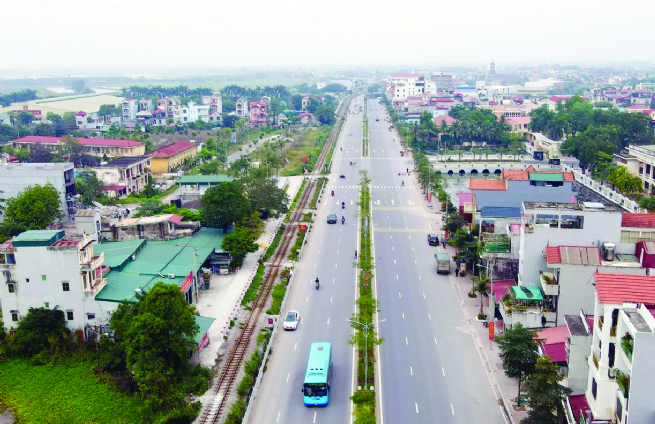9:30:05 AM | 6/12/2025
Maintaining and improving the quality of criteria in communes that have achieved new rural standards is a key issue for all localities after years of effort to reach these targets.

The landscape of Dong Quang commune, Ba Vi district
Like other areas during new rural development, Duong Quang commune (Gia Lam district) faced many difficulties, but through great effort, it completed the program by late 2016 and was recognized by the Hanoi People's Committee as meeting new rural standards. In 2023, the commune achieved advanced new rural standards. However, the achievement did not lead the Party Committee, authorities, or people to neglect the task of maintaining and improving the quality of the criteria already met.
Chairman of Duong Quang Commune People's Committee Nguyen Viet Doi shared that in implementing the advanced new rural program, the commune’s infrastructure has been continuously upgraded to better serve residents’ living needs. Gia Lam district invested in 19 projects with a total capital of over VND200 billion to complete rural roads, intra-field traffic routes, renovate cultural facilities, build schools, and embank ponds.
To date, Duong Quang’s traffic infrastructure has been synchronously developed in line with urbanization: 100% of commune, inter-commune, and connecting roads to district routes, with a total length of 5.3 km, have been asphalted. The system of village, alley, and hamlet roads includes 204 routes with a total length of 27.7 km, all concreted and asphalted through joint investment by the city, district, commune, and contributions from residents. These roads are regularly maintained by authorities, organizations, and local people, ensuring cleanliness, shade trees, lighting systems, traffic signs, instructions, and speed bumps as regulated, creating green, clean, and orderly surroundings.
Every year, Duong Quang commune effectively carries out the movement "All people unite to build a new cultural life." To date, all 9 villages with cultural houses have achieved and maintained the title of "Cultural Village," while 96.6% of households have earned the title of "Cultural Family." Cultural houses in the commune have been repaired and upgraded with additional facilities to better serve community meetings, cultural events, and artistic activities. The commune has also installed outdoor fitness equipment at community spaces, meeting the exercise and health needs of residents of all ages.

According to the Hanoi Coordination Office of the New Rural Development Program, as of now, all 382 communes in the city have met Criterion No. 2 on traffic under the National Criteria for New-Style Rural Communes for the 2021–2025 period. This criterion imposes strict standards on traffic infrastructure to ensure it meets the daily travel, production, and goods trading needs of the people. Specifically, all main roads within the commune, including commune, village, and inter-village roads, must be asphalted or concreted to allow convenient car travel throughout the year. In addition to technical standards, the criterion also requires consistency in planning, landscape design, and environmental sanitation.
In recent years, Hanoi has concentrated resources on implementing numerous rural traffic projects. The entire network of commune roads, village roads, and inter-village roads across the city has been renovated, upgraded, and fully asphalted or concreted to meet technical standards, ensuring smooth and convenient car travel year-round.
According to the latest review, many alleys in Hanoi have also been reinforced and cleaned, providing safe, accessible routes for residents. In addition, the intra-field transport system, essential for moving agricultural products and materials, has seen significant improvements. These roads support agricultural mechanization, enhance labor productivity, reduce post-harvest losses, and expand market access for local farm products.
The completion of Criterion No. 2 has not only improved transportation but also brought about broad, positive changes to rural life in Hanoi. Upgraded infrastructure helps shorten travel times, lower transport costs, and boost production and business efficiency for both local people and enterprises.
However, for districts aiming to meet advanced new rural standards, school-related criteria remain challenging. The pace of connecting to centralized clean water systems is still slow, and the transformation and restructuring of the agricultural economy have yet to match Hanoi’s potential and advantages. Business investment in agricultural production remains modest, especially in deep processing; high-tech farming is limited, and livestock and poultry diseases continue to pose outbreak risks. The number of production–consumption chains is small, making product distribution difficult. Many occupations and craft villages are scattered, unsustainable, and small in scale, limiting investment, upgrades, and technology application.
According to Decision No. 372 of the Prime Minister, five years after meeting new rural standards, localities must undergo re-evaluation. Not only in Duong Quang but in many communes across Hanoi, while most criteria remain at acceptable levels, some indicators are incomplete or of low quality, and certain items remain unfinished. In several areas, people still heavily depend on State resources. To avoid falling off the list of qualified communes, it is essential for localities to actively maintain, improve, and develop their criteria. A key priority is raising people’s quality of life, earning their trust and cooperation in sustaining and advancing the program.
By Dinh Bao, Vietnam Business Forum
| This special section is supported by Hanoi Coordination Office of the New Rural Development Program |